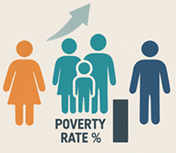Login to LISSY
LISSY is a remote-execution data access system for the LIS and LWS microdata... learn more ≫
Login to Web Tabulator
Design and generate descriptive cross-national tables based on LIS datasets... learn more ≫
This call for proposals is in the context of the (LIS)2ER initiative – an institutional collaboration between the LIS Data Center in Luxembourg (LIS) and the Luxembourg Institute for Socio-Economic Research (LISER). Both institutions are located in the Maison des Sciences Humaines at Belval Campus in Luxembourg.
The collaboration aims to foster collaborative research on Policies to Fight Inequality. Grants for research visits is one of the instruments in place to this end. Research proposals can be submitted by individual researchers or by small teams of up to three researchers. Applicants from any level of seniority will be considered and we hope to strike a balance between junior and senior visitors.
Visitors will be hosted on LIS or LISER premises and will have privileged access to LIS and LWS microdata on-site in a secure data access lab for the duration of their visit.
We expect visitors to engage with local researchers at the LISER, LIS and the University of Luxembourg – all based on campus. (Potential or foreseen collaboration with local researchers will be a key criterion for the selection of proposals.)
Expected Output
Visitors are expected to present their findings in a seminar and produce a research note (policy brief) summarizing their results, which will be published in the LIS Inequality Matters Newsletter and, where appropriate, the LISER Policy Brief Series. Any resulting research papers will be included in the LIS and LISER Working Paper Series. Visitors may also give an interview at the end of their stay to support communication and outreach through LIS and LISER channels.
Timing
In this call, we are happy to consider applications for research visits of any duration from 2 to 8 weeks and for any time period from March to December 2026 (except the period mid-July to mid-August).
Calendar
- Submission of proposals: January 31, 2026 .
- Communication of decision: February 15, 2026 .
- Earliest start date: March 1, 2026 .
The Call
More information about the call, funding, and how to apply is available here.
by Anne-Catherine Guio, (Luxembourg Institute of Socio-Economic Research (LISER)), and Chiara Mussida, (Università Cattolica del Sacro Cuore)
Household dissolution may be harmful for separated parents and their children. Single-parent households face significantly higher poverty risks compared to two-parent families, highlighting the vulnerability associated with limited income sources and greater costs. The article highlights the role of alimony (child maintenance) in redistributing income between separated parents to protect children’s living standards. Using Luxembourg Income Study data, the authors explore how alimony affects the resources and poverty risks of both paying and receiving parents.
Full article is available here.
by Nicole Kapelle, (Trinity College Dublin) and Andreas P. Weiland, (Technical University of Dortmund)
Financial security in retirement is increasingly shaped by the opportunities and constraints individuals face across their working lives. As pension systems in many OECD countries have moved towards greater reliance on individual contributions and private savings, continuous employment and stable earnings have become more important for determining economic stability in old age. This article analyses financial inequalities within retired couples, highlighting persistent gender gaps in pensions and wealth, especially in West Germany. Using the LIS data, these findings are then compared from a cross-national perspective.
Full article is available here.
by Gabriele Mariani, (University of Antwerp)
Research on income poverty has largely focused on households with children, given children’s vulnerability and the long-term consequences of child poverty. As a result, childless households, especially singles, have received far less attention despite their growing numbers and rising poverty risks. Based on the LIS data, this article examines relative income poverty among childless adults across welfare states, comparing how tax-transfer systems reduce poverty across demographic groups and in contrast to households with children.
Full article is available here.
by Alessio Fusco, (Luxembourg Institute of Socio-Economic Research (LISER)), and Philippe Van Kerm, (University of Luxembourg, LIS Cross-National Data Center in Luxembourg (LIS)
Over the past four decades, Luxembourg has seen strong economic and population growth, with average real disposable income more than doubling between 1985 and 2023. Despite this prosperity, relative poverty remains significant and rising: 18.1% of the population is currently at risk of poverty, up from earlier levels. This paper examines Luxembourg’s poverty trends, showing that rising living standards have coincided with increasing relative poverty driven by inequality, demographic change, and comparatively high risks among children and lone-parent families in cross-national view.
Full article is available here.
by Kun Lee, (LIS & LISER)
On November 27-28, the LIS Cross-National Data Center and LISER co-hosted the 2025 (LIS)²ER–SHARE Luxembourg Joint Workshop on “Pensions and Old-age Well-being: Policy Challenges in Ageing Societies”. This article provides a brief synopsis of the event.
Full article is available here.
LIS is happy to announce the following data updates:
- Austria (1 new LIS dataset and 1 revised) – one new dataset (AT23) added to the LIS Database.
Read more » - Canada (1 new LIS dataset; 1 new LWS dataset and 2 revised) – one new dataset (CA22) added to the LIS Database and (CA23) added to the LWS Database.
Read more » - Chile (1 new LWS dataset and 4 revised) – one new dataset (CL24) added to the LWS Database.
Read more » - Czechia (15 new LIS datasets and 8 revised) – annualisation of the series from CZ05 to CZ23 in the LIS Database.
Read more » - Ireland (2 new LIS datasets and 20 revised) – two new datasets IE22 and IE23 added to the LIS Database.
Read more » - Israel (1 new LIS dataset and 25 revised) – one new dataset (IL22) added to the LIS Database.
Read more » - Panama (20 new LIS datasets and 4 revised) – annualisation of the series from PA96 through PA19 in the LIS Database.
Read more » - United States (1 new LIS dataset) – one new dataset (US24) added to the LIS Database.
Read more » - Switzerland (3 revised LIS datasets) – revisions to the Swiss LIS series CH20 to CH22 .
Read more » - works consistently across R and Stata,
- relies on cumulative weights, which ensures stability when computing shares or averages within distributional groups. Such estimates can be highly sensitive on small subsamples and when many repeated values or ties are observed in the microdata.
- R users may rely on the ‘lissyrtools’ package, which implements definition 4 by default, when using the relevant functions;
- Stata users may use the ‘percentils’ command developed by Philippe Van Kerm, which is pre-installed and ready to use in LISSY.
- January 31, 2026: Deadline for Abstract Submissions
- March 15, 2026: Registration Opens
- April 15, 2026: Early Registration Deadline
- May 31, 2026: Registration Deadline for Presenters
![]() Click on `Read more’ to access more details on the newly added and revised datasets
Click on `Read more’ to access more details on the newly added and revised datasets
With the Winter data release, LIS is adopting the updated 2021 Purchasing Power Parity (PPP) rates issued by the World Bank in May 2024. These new PPPs, produced with improved data collection and methodological refinements, offer more accurate cross-country comparisons by better reflecting real price-level differences.
The World Bank has also revised its international poverty lines (June 2025), increasing all thresholds to account for inflation and updated national standards.
LIS has assessed how these updates—the new PPP base year and revised poverty lines—affect indicators such as median income and absolute poverty, providing users with an initial benchmark for updating their own estimates.
For further details on this update, please consult this article by Gonçalo Marques, (LIS) here. An extended LIS Technical Working Paper is accessible from here.
Note: PPP values for 2017, and 2011 remain available and accessible on the LIS website and through the LISSY system.
Beginning with the Winter data release of December 2025, LIS adopts definition 4 from Hyndman & Fan (1996) for the computation of the Key Figures and all percentile-based estimates (median, percentile ratios, poverty lines based on the median, decile shares, etc.). Under this definition, a percentile is obtained by locating its position in the cumulative distribution and linearly interpolating between the two adjacent ordered values, producing smooth and stable estimates.
We are adopting this method because it:
As a result, previously published figures have been revised to align with this unified approach. Even indicators not directly based on percentiles may be affected, as an interquartile rule is applied to cap top and bottom coded disposable household incomes in every dataset. Only 36 statistics showed a difference larger than 1 % between old and new estimate (=0.23 % of all concerned statistics). Nevertheless, even with a harmonized methodology, minor precision differences across software environments may still occur, but these remain rare.
To ensure consistent replication, users can already apply this methodology in LISSY:
Reference scripts illustrating these procedures are available in the Replication Code section of the LIS website here.
Please note that DART has not yet been updated to this new methodology; its revision is planned for an upcoming release.
For further questions, please contact usersupport@lisdatacenter.org.
Description
The International Conference on Economic Modeling and Data Science will take place in Luxembourg, on July 8–10, 2026. The event will be hosted by the National Institute of Statistics and Economic Studies (STATEC) on the premises of the University of Luxembourg in Esch/Belval.
This year’s conference will be held under the theme “Data Science for Economics” and will run back-to-back with the European Association for Data Science Summer School. EcoMod2026 will provide a unique forum for exchanging ideas, methodologies, and empirical insights among academics, policymakers, and practitioners engaged in quantitative analysis for policy formulation and decision-making.
The conference is supported by several key national institutions that produce knowledge and data for policy: STATEC Research, the General Inspectorate of Social Security (IGSS), and the Luxembourg Inland Revenue (ACD). Colleagues who are unable to travel to Luxembourg will be able to present their papers virtually. EcoMod2026 welcomes submissions in all areas of economic modeling and data science.
Submission
Please submit abstracts, full papers, or session proposals no later than January 31, 2026, via the Conference Maker platform: https://editorialexpress.com/conference/ecomod2026/.
Proposals for special sessions may be submitted directly by email to ecomod2026@statec.etat.lu or to the conference co-chairs.
Important Dates
More Information
For more information on registration categories, participation fees, and accommodation options, please check the conference website.
What's new?
Call for proposals: Research stays in Luxembourg
2026 Call for Visitors at LIS and LISER within the (LIS)2ER Initiative is Now Open!
Alimony received and paid: What is the impact on the risk of poverty after separation?
This article analyses how alimony redistributes resources and affects poverty risks after parental separation.

Behind Closed Doors: Intra-Couple Pension and Wealth Gaps in Germany and Beyond
This article examines gendered pension and wealth inequalities within retired couples from a cross-national perspective.

Childless households and relative income poverty outcomes: a cross-country comparison
This article compares poverty risks among childless adults across welfare states using LIS data.

Poverty trends in Luxembourg 1985–2023
This article shows rising relative poverty in Luxembourg, especially among children, despite strong income growth.
Highlights from the 2025 (LIS)2ER-SHARE Luxembourg Workshop: “Pensions and Old-age Well-being: Policy Challenges in Ageing Societies
A brief synopsis of the Joint Workshop on “Pensions and Old-age Well-being: Policy Challenges in Ageing Societies”.
